The Pacific Northwest has the best environment in the country for strawberries and rhubarb. In fact, some 80% of the nation's rhubarb comes from Sumner, a nearby city. I bought my strawberries in the Puyallup (pew-ALL-up) valley.
Puyallup was known in the '30s and '40s as THE place to grow berries. It still is, in many respects. Many of the farms were owned by Japanese immigrants, who lost everything in the forced internments of the early '40s. It's a piece of American history that we should never forget, nor repeat.


Here are the strawberries we bought in Puyallup today. We got 2 whole flats. I processed just one of them.

When I was a kid, my family went to Puyallup to get blueberries, rabbit feed, and cucumbers. In fact, it's where I still get my chicken feed sometimes. The farmland in the Puyallup Valley is spectacular: rich and productive. It's important to me to buy fruit from there because much of the valley has been paved over and covered with warehouses. When we buy local strawberries, not only do they taste better (those cruddy ones from CA has no taste because they're bred to travel well), the farmers have good reason to resist being bought out by big businesses and housing developments.
What should you do with your strawberries and rhubarb? You might want to make this recipe, like I did: http://www.preservefood.com/canning/reciped.shtml.
First, you need to clean and hull the strawberries. A bonus for the chickens is that they get to nibble the hulls.

If you're lucky, like I am, your grandma might have a massive rhubarb plant that is as old as it is large. She'll ply you with rhubarb stalks because she doesn't eat them anymore.

Clean and chop up the rhubarb.

Measure out 4 cups of rhubarb.

Then measure out 4 cups of strawberries. Mine shows a bit extra because I didn't crush the berries.

Add 4 T lemon juice. It should be bottled juice so that the acidity is guaranteed, but I didn't have any so used fresh (cardinal sin of canning!). Oh well. In this case it's for color preservation more than anything. I found this pressed glass juicer that had belonged to my great-grandmother in my grandmother's root cellar.
I wish I had a root cellar.

Put these in gredients into a large stock pot. It'll look like the pot is too big, but believe me: you'll want to have the high sides once this stuff starts to boil and spit out globules of molten goo. Don't forget the salt.

Bring it to a hard boil, which means that if you stir it, the boil won't go down. Beware of steam.

Add the box of pectin and bring the mix to a boil again. Once it has boiled for 1 minute, add the sugar. Yes, that's 10 cups of sugar.
Hey, I never said that jam was low-cal.

Boil it, stirring vigorously, until the temperature hits 220 degrees. This is the easiest way to ensure a set. Think of making jam like making candy: the mixture will behave certain ways (i.e. "gel") at prescribed temperatures. In this case, 220 is the magic temp.
Put the jam in the prepared jars, wipe rims, put on lids, finger tighten, and process for 5 minutes. Remember that you start the 5 mins once the water starts to boil.
Last week I found 24 pint jars on the side of the road. SCORE!! Free jars are any canner's best friend(s).

If you're speedy, you can put a batch of jars to process while you make the next batch of jam. You can't double the batches or the pectin won't set.
I made 2 batches of strawberry-rhubarb jam and 1 batch of plain strawberry, for a total of 15 jars. It took about 2 hours start to finish. Getting the water to boil for processing the jars always is the longest part of the process at my house. I always start the water before I do anything else.
Summer will last in my household well into the winter.
Puyallup was known in the '30s and '40s as THE place to grow berries. It still is, in many respects. Many of the farms were owned by Japanese immigrants, who lost everything in the forced internments of the early '40s. It's a piece of American history that we should never forget, nor repeat.


Here are the strawberries we bought in Puyallup today. We got 2 whole flats. I processed just one of them.
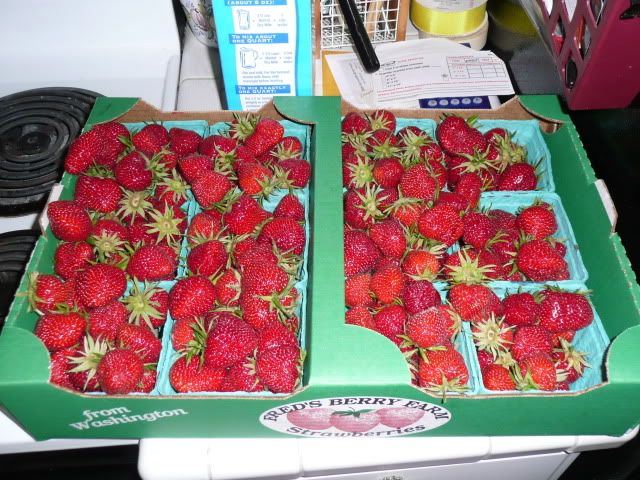
When I was a kid, my family went to Puyallup to get blueberries, rabbit feed, and cucumbers. In fact, it's where I still get my chicken feed sometimes. The farmland in the Puyallup Valley is spectacular: rich and productive. It's important to me to buy fruit from there because much of the valley has been paved over and covered with warehouses. When we buy local strawberries, not only do they taste better (those cruddy ones from CA has no taste because they're bred to travel well), the farmers have good reason to resist being bought out by big businesses and housing developments.
What should you do with your strawberries and rhubarb? You might want to make this recipe, like I did: http://www.preservefood.com/canning/reciped.shtml.
First, you need to clean and hull the strawberries. A bonus for the chickens is that they get to nibble the hulls.
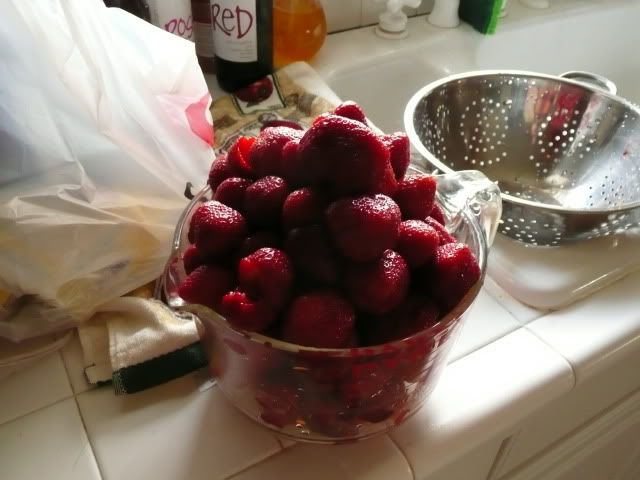
If you're lucky, like I am, your grandma might have a massive rhubarb plant that is as old as it is large. She'll ply you with rhubarb stalks because she doesn't eat them anymore.
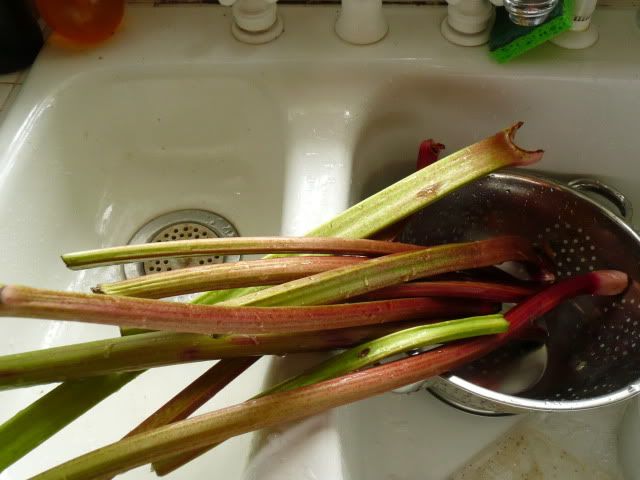
Clean and chop up the rhubarb.
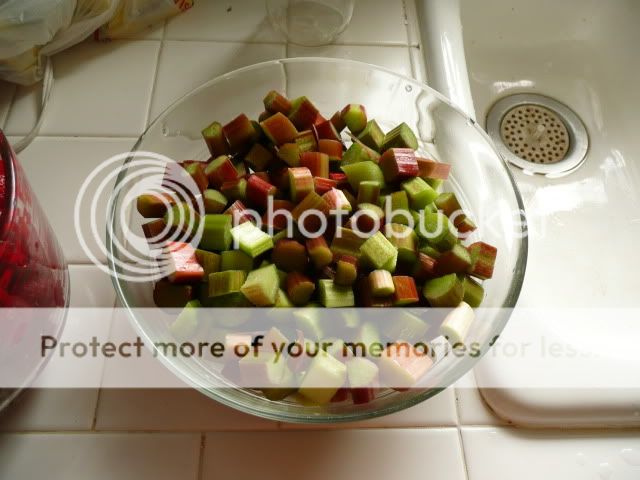
Measure out 4 cups of rhubarb.
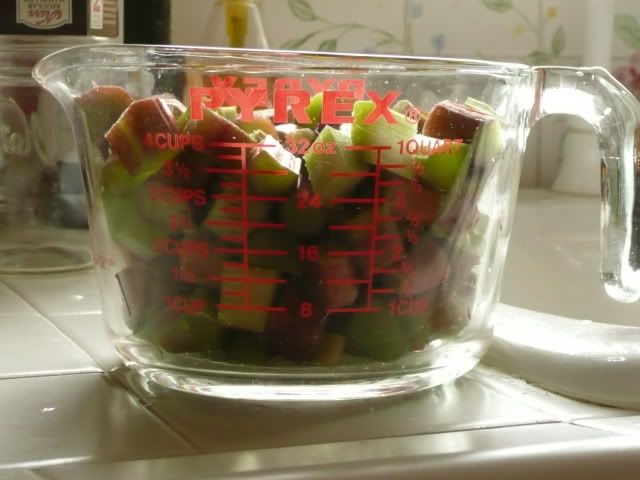
Then measure out 4 cups of strawberries. Mine shows a bit extra because I didn't crush the berries.
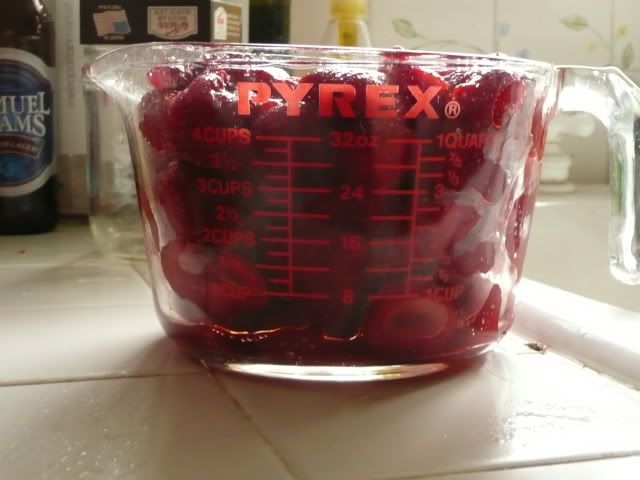
Add 4 T lemon juice. It should be bottled juice so that the acidity is guaranteed, but I didn't have any so used fresh (cardinal sin of canning!). Oh well. In this case it's for color preservation more than anything. I found this pressed glass juicer that had belonged to my great-grandmother in my grandmother's root cellar.
I wish I had a root cellar.
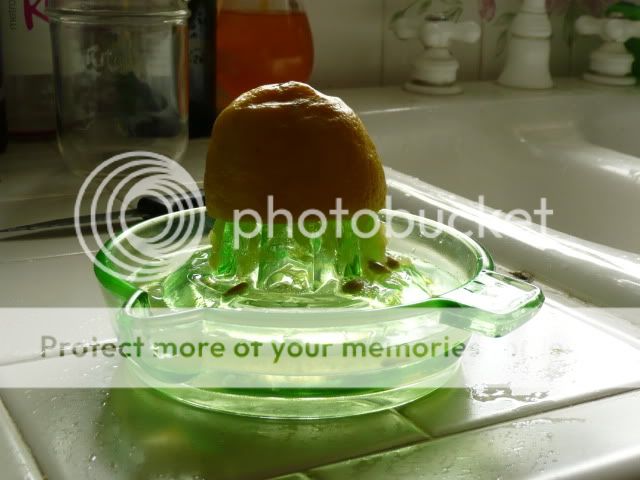
Put these in gredients into a large stock pot. It'll look like the pot is too big, but believe me: you'll want to have the high sides once this stuff starts to boil and spit out globules of molten goo. Don't forget the salt.
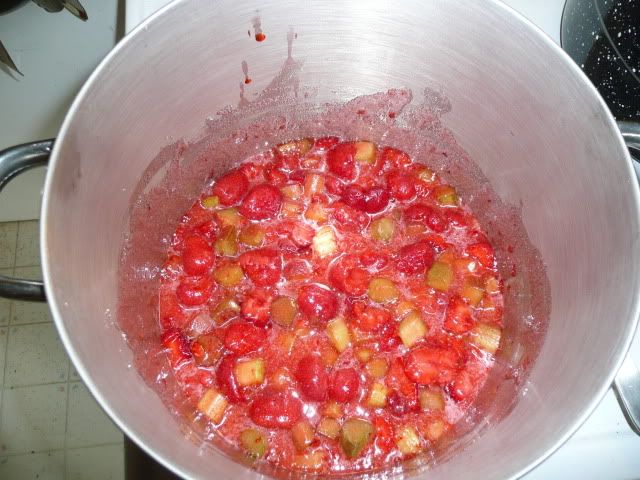
Bring it to a hard boil, which means that if you stir it, the boil won't go down. Beware of steam.
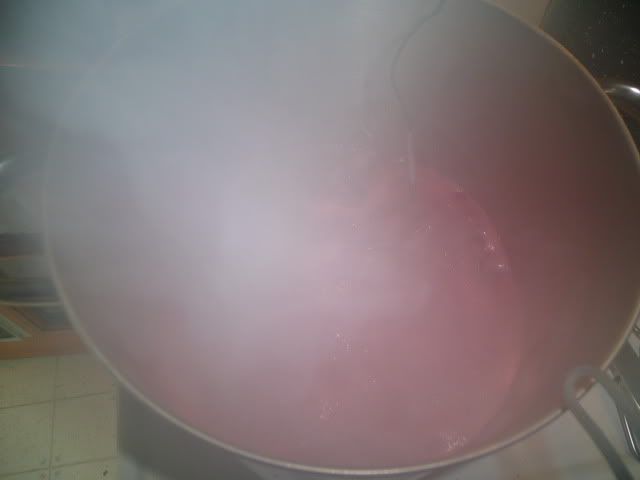
Add the box of pectin and bring the mix to a boil again. Once it has boiled for 1 minute, add the sugar. Yes, that's 10 cups of sugar.
Hey, I never said that jam was low-cal.
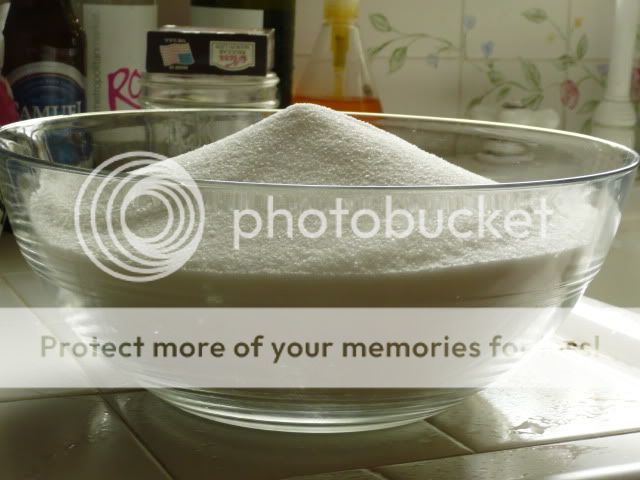
Boil it, stirring vigorously, until the temperature hits 220 degrees. This is the easiest way to ensure a set. Think of making jam like making candy: the mixture will behave certain ways (i.e. "gel") at prescribed temperatures. In this case, 220 is the magic temp.
Put the jam in the prepared jars, wipe rims, put on lids, finger tighten, and process for 5 minutes. Remember that you start the 5 mins once the water starts to boil.
Last week I found 24 pint jars on the side of the road. SCORE!! Free jars are any canner's best friend(s).
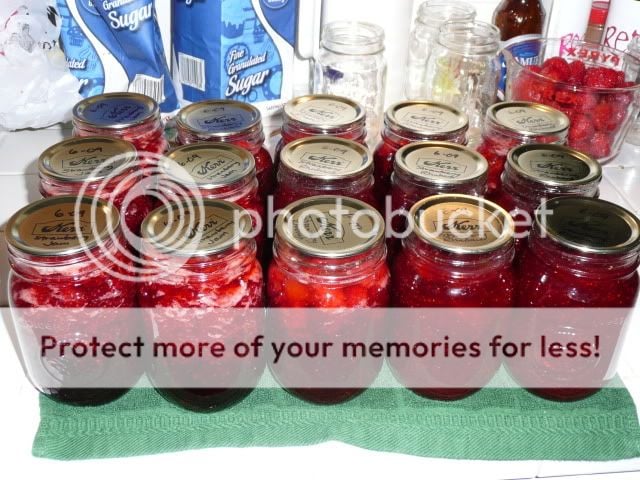
If you're speedy, you can put a batch of jars to process while you make the next batch of jam. You can't double the batches or the pectin won't set.
I made 2 batches of strawberry-rhubarb jam and 1 batch of plain strawberry, for a total of 15 jars. It took about 2 hours start to finish. Getting the water to boil for processing the jars always is the longest part of the process at my house. I always start the water before I do anything else.
Summer will last in my household well into the winter.




